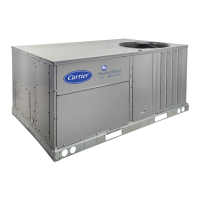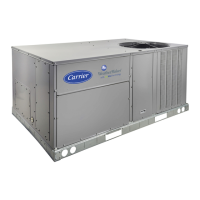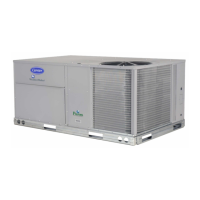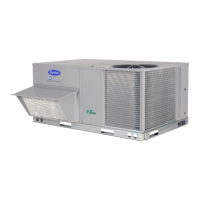THIRD PARTY CONTROL
Thermostat E The method of control would be through
the thermostat inputs:
Y1 = first stage cooling
Y1 and Y2 = first and second stage cooling
Wl = first stage heating
Wl and W2 = first and second stage heating
G = supply fan
Alarm Output E The alarm output TB4-7 and 8, will pro-
vide relay closure whenever the unit is under an alert or alarm
condition.
Remote Switch _ The remote switch may be configured
for three different functions. Under Configuration --+UNIT, set
RM. (T" to one of the following:
0 = no remote switch
1 = occupied/unoccupied switch
2 = start!stop switch
3 = occupancy ovemde switch
With RM. CF set to 1, no time schedules are followed and
the unit follows the remote switch only in determining the state
of occupancy.
With RM. CF set to 2, the remote switch can be used to shut
down and disable the unit, while still honoring tflne guards on
compressors. Time schedules, internal or external, may be run
simultaneously with this configuration.
With RM.CF set to 3, the remote input may override an
unoccupied state and force the control to go into occupied
mode. As with the start/stop configuration, an internal or exter-
nal time schedule may continue to control occupancy when the
switch is not in effect.
Under (bnfiguration-+SW.LG---_RMI.L, the remote occu-
pancy switch can be set to either a normally open or normally
closed switch input. Normal is defined as either unoccupied, start
or "not currently overridden," respective to the RM.CF
configuration.
VFD Control _ On VFD equipped supply fans, supply
duct static pressure control may be left under unit control or be
externally controlled. To control a VFD externally with a 4 to
20 mA signal, set SRRS to 4, under the Configuration--+SP
menu. This will set the reset to VFD control. When SRRS = 4,
the static pressure reset function acts to provide direct VFD
speed control where 4 mA = 0% speed and 20 mA = 100%
(SRMN and SRMX will ovemde). Note that SRCF must be
set to 1 (VFD Control) prior to configuring SRRS = 4. Failure
to do so could result in damage to ductwork due to overpressur-
ization. In effect, this represents a speed control signal "pass
through" under normal operating circumstances. The
(bnfortLink controller ovemdes the third party signal for crit-
ical operation situations, most notably smoke and fire control.
Wire the input to the controls expansion module (CEM) using
TB-11 and 12. An optional CEM board is required.
See Appendix C and the VFD literature supplied with the unit
for VFD configurations and field wiring connections to the VFD.
Supply Air Reset -- With the installation of the CEM,
the (_mfortLink controller is capable of accepting a 4 to
20 mA signal, to reset the supply-air temperature up to a maxi-
mum of 20 E See VFD Control section above.
Demand Limit Control _ The term "demand limit
control" refers to the restriction of the machine's mechanical
cooling capacity to control the amount of power that a machine
may use.
Demand limiting using mechanical control is possible via two
means:
Two discrete inputs tied to demand lhnit set point percentages.
OR
A 4 to 20 mA input that can reduce or limit capacity linearly to
a set point percentage.
In either case, it will be necessary to install a controls ex-
pansion module (CEM).
DEMAND LIMIT DISCRETE INPUTS -- First, set DM.L.S
in (bnfiguration-+DMD.L to 1 (2 switches).
When Inputs-cGEN.I-cDL.S1 (Demand Switch no. 1) is
OFF, the control will not set any limit to the capacity, and
when ON, the control sets a capacity limit to the Configura-
tion--cDMD.L -¢D.L.S1 set point.
Likewise, when Inputs-cGEN.I-cDL.S2 (Demand Switch
no. 2) is OFF, the control will not set any limit to the capacity,
and when ON, the control sets a capacity lflnit to the Configu-
ration--cDMD.L--cD.L.S2 set point.
If both switches are ON, Inputs-cGEN.I-cDL.S2 is used
as the limiter of capacity.
Under (bnfiguration--cSW..LG set the logic state appropri-
ately for the action desired. Set the DL1.L and DL2.L configu-
rations. They can be set normally open or normally closed. For
example, ifDL1.L is set to OPEN, the user will need to close
the switch to cause the control to limit capacity to the demand
limit 1 set point. Likewise, if DL1.L is set to CLSE (closed),
the user will need to open the switch to cause the control to
limit capacity to the demand limit 1 set point.
DEMAND LIMIT 4 TO 20 mA INPUT -- Under (bnfigu-
ration--cDMD.L, set configuration DM.L.S to 2 (2 = 4 to
20 mA control). Under the same menu, set D.L.20 to a value
from 0 to 100% to set the demand lflnit range. For example,
with D.L.20 set to 50, a 4 mA signal will result in no limit to
the capacity and 20 mA signal will result in a 50% reduction in
capacity.
Demand Controlled Ventilation Control
There are multiple methods for externally controlling the econ-
omizer damper.
IAQ DISCRETE 1NPUT CONFIGURATION-- The IAQ dis-
crete input configuration requires a CEM module (optional) to
be installed and an interface to a switch input at TB5-6 and 7.
The state of the input on the display can be found at
Inputs --)AIR. Q--+IA Q.I.
Before configuring the switch functionality, first determine
how the switch will be read. A closed switch can indicate either
a low IAQ condition or a high IAQ condition. This is set at
Configuration-+SW.LG and IAQ.L. The user can set what a
low reading would mean based on the type of switch being
used. Setting IAQ.L to OPEN means that when the switch is
open the input will read LOW. When the switch is closed, the
input will read HIGH. Setting IAQ.L to CLSE (closed) means
that when the switch is closed the input will read LOW, and
therefore, when the switch is open the switch will read HIGH.
There are two possible configurations for the IAQ discrete
input. Select item (bnfiguration--clAQ--)AQ.CF--clQ.LC
and configure for either 1 (IAQ Discrete) or 2 (IAQ Discrete
Override).
IQ.L C = 1 (IAQ Discrete) -- If the user sets IQ.L C to 1 (IAQ
Discrete), and the switch logic ((bnfiguration--cSW.LG--€
IAQ.L) is set to OPEN, then an open switch reads low and a
closed switch reads high.
If the switch is open, the economizer will be colmnanded to
the IAQ Demand Vent Minimum Position.
These settings may be adjusted and are located at (bnfigura-
tion --+IAQ--+DC V.C-+IA Q.M.
If the switch is closed, the IAQ reading will be high and the
economizer will be colmnanded to the Economizer Minimum
Position.
This setting may be adjusted and is located at Configura-
tion --dA Q --cDC V.C-cE C MN.
31

